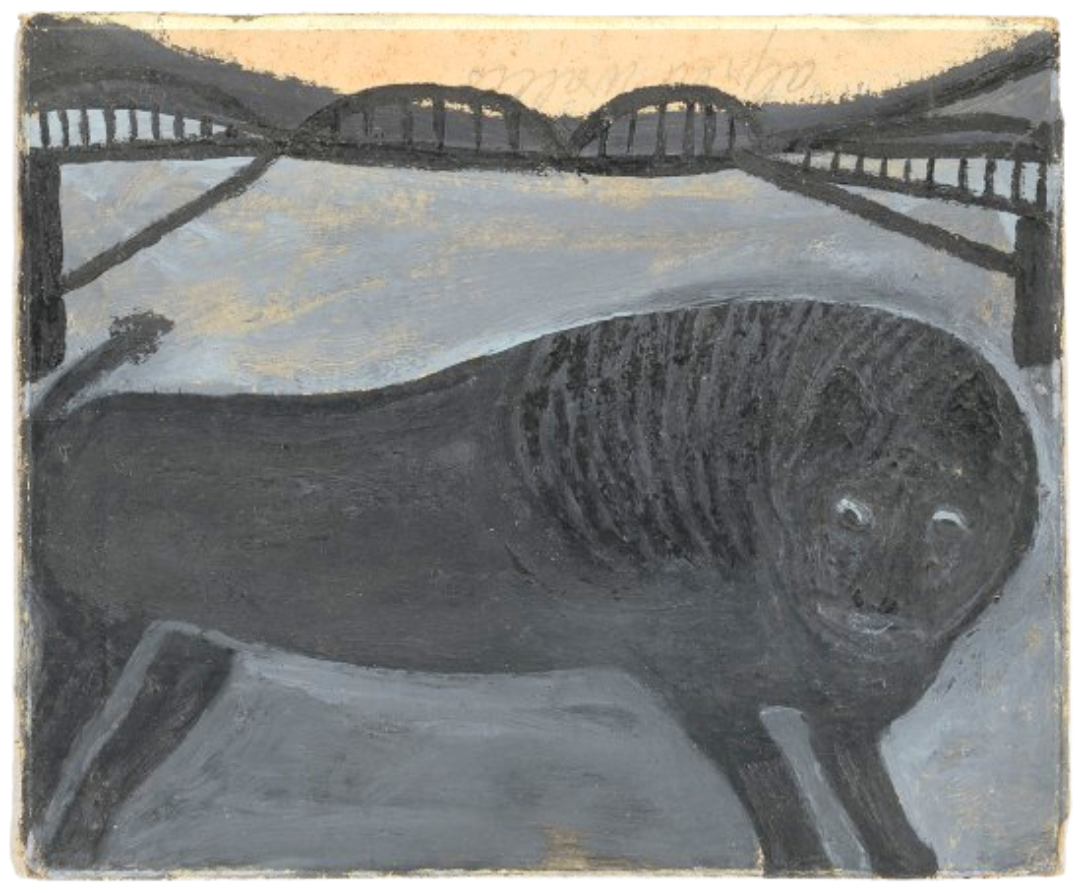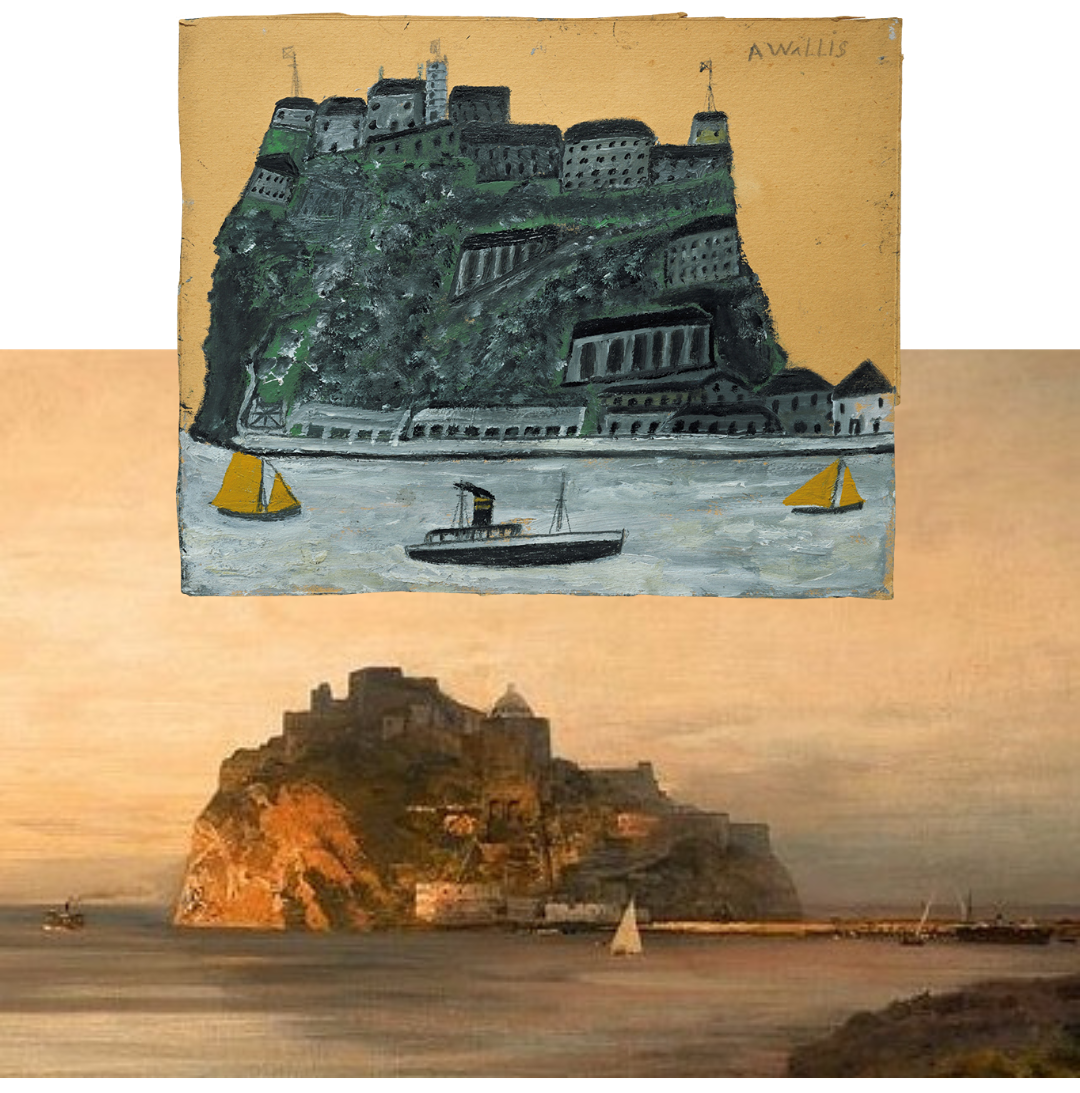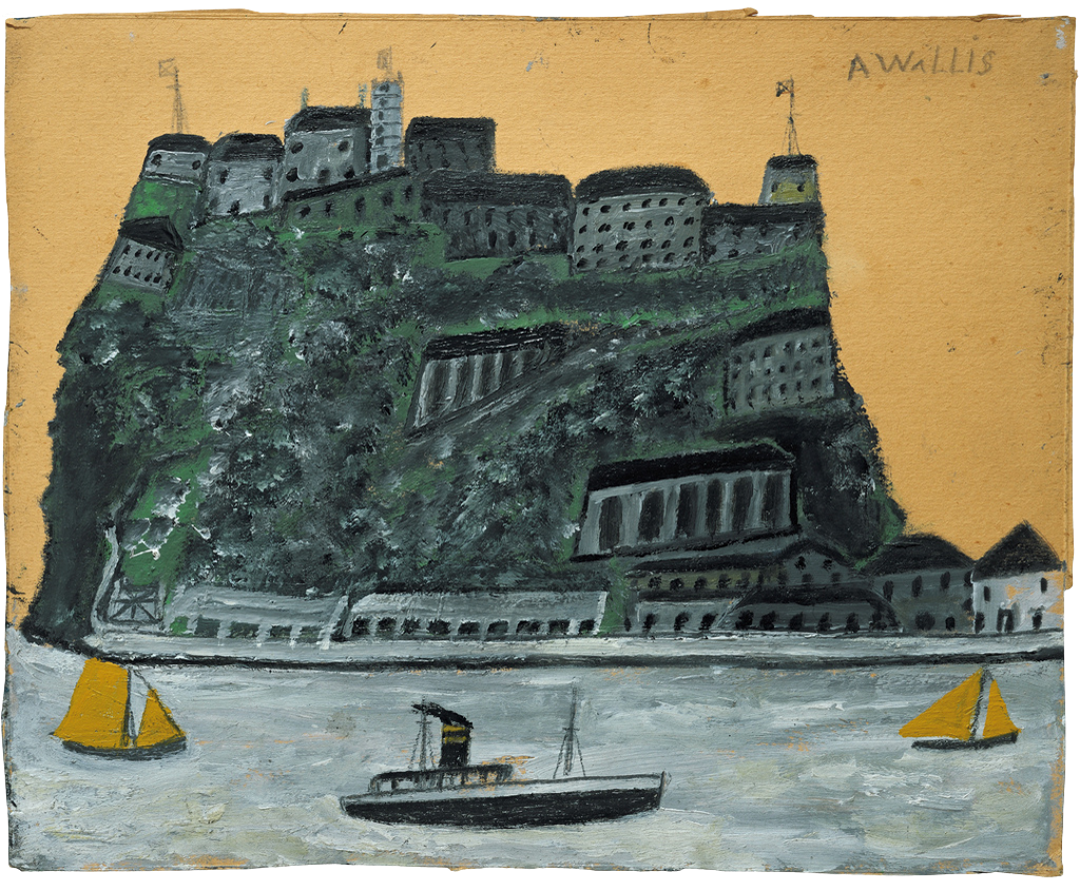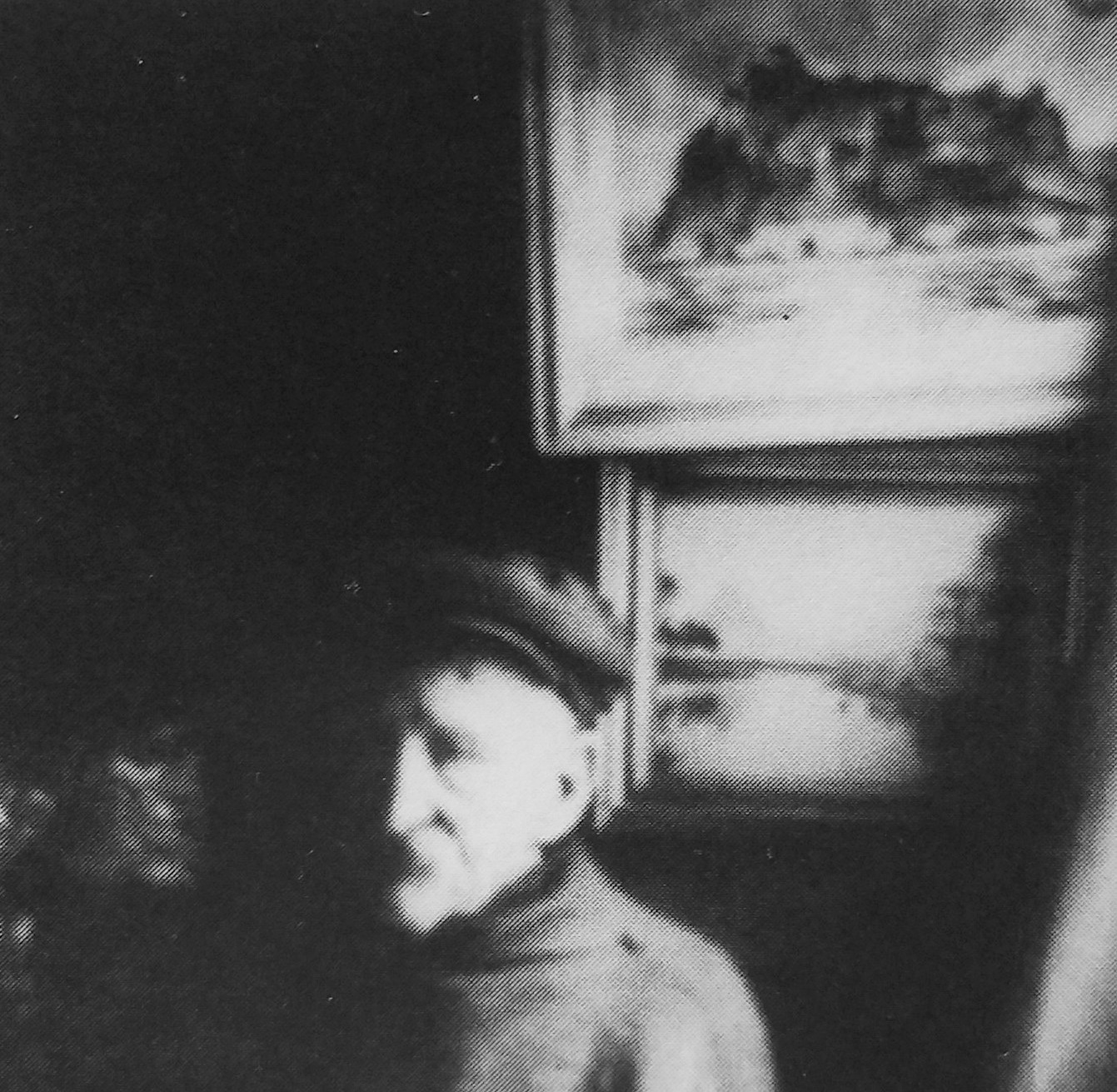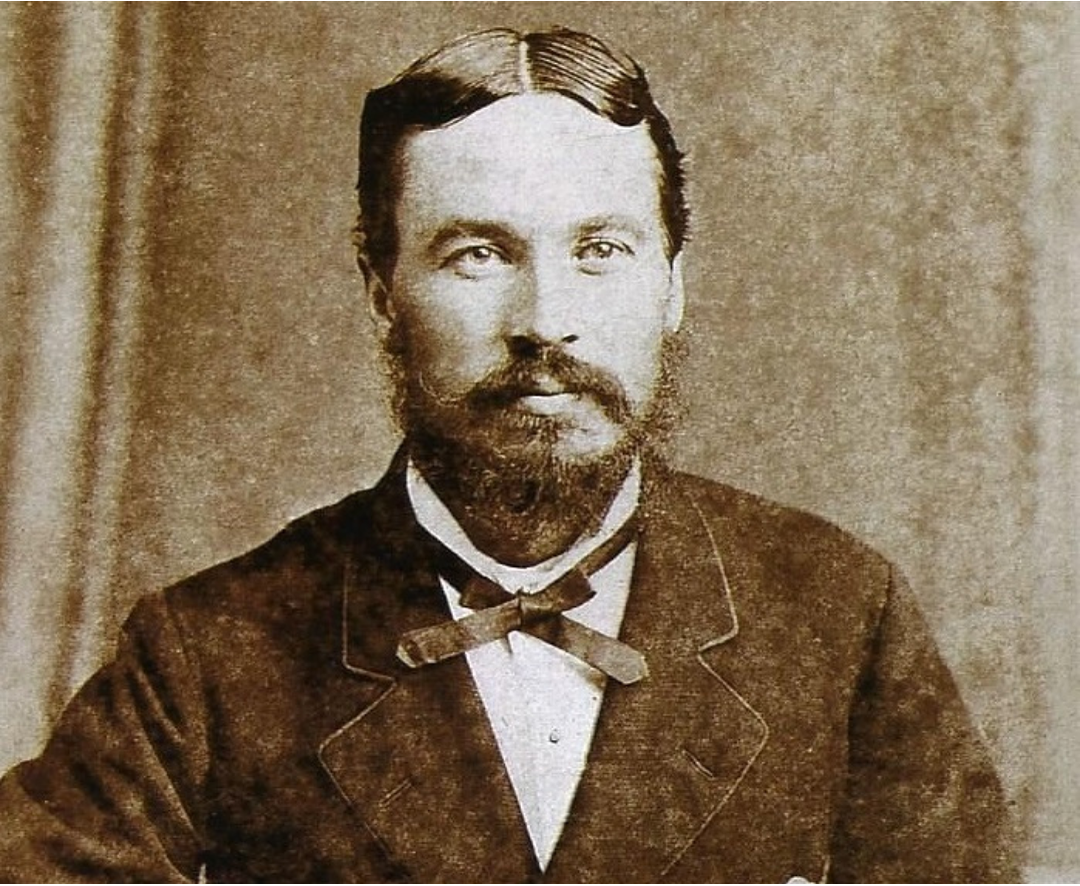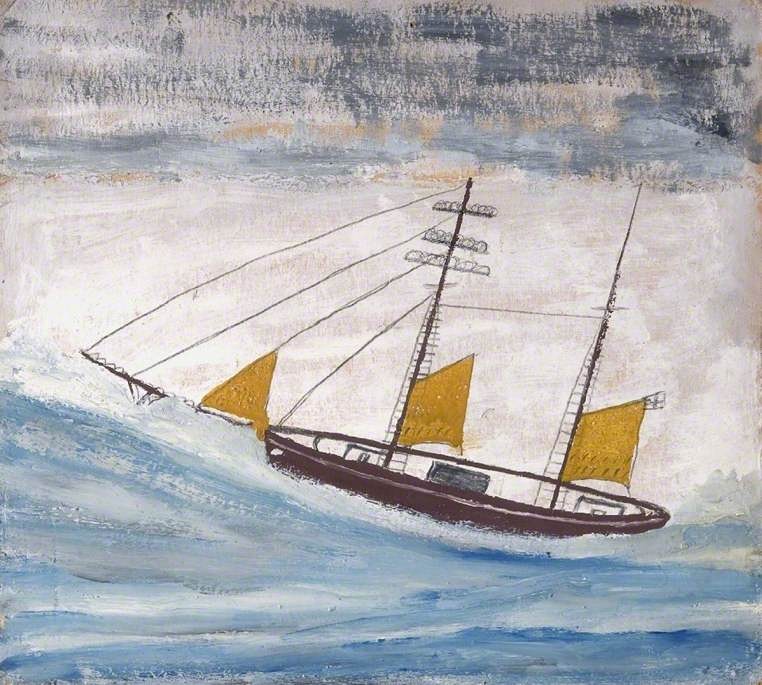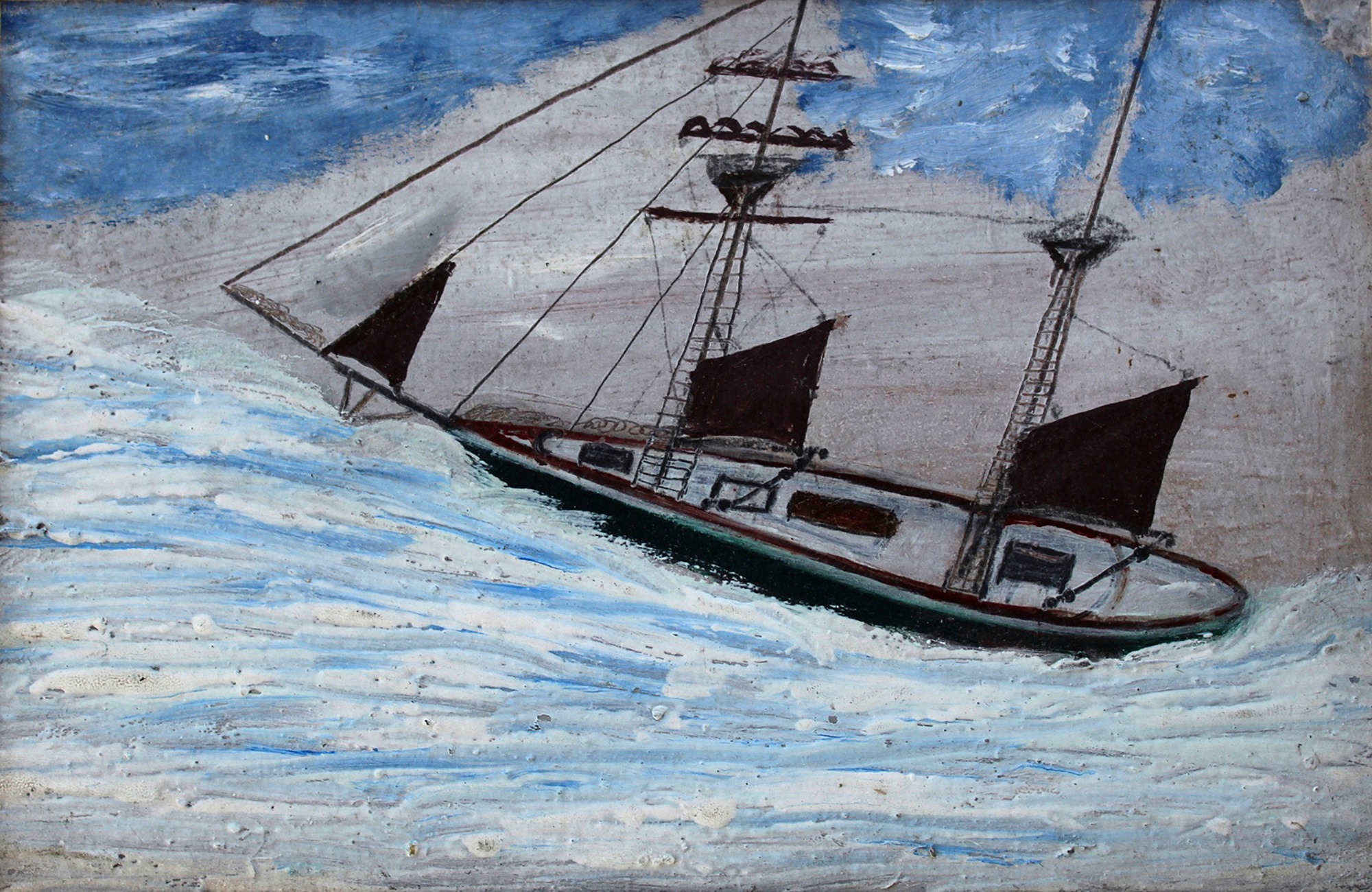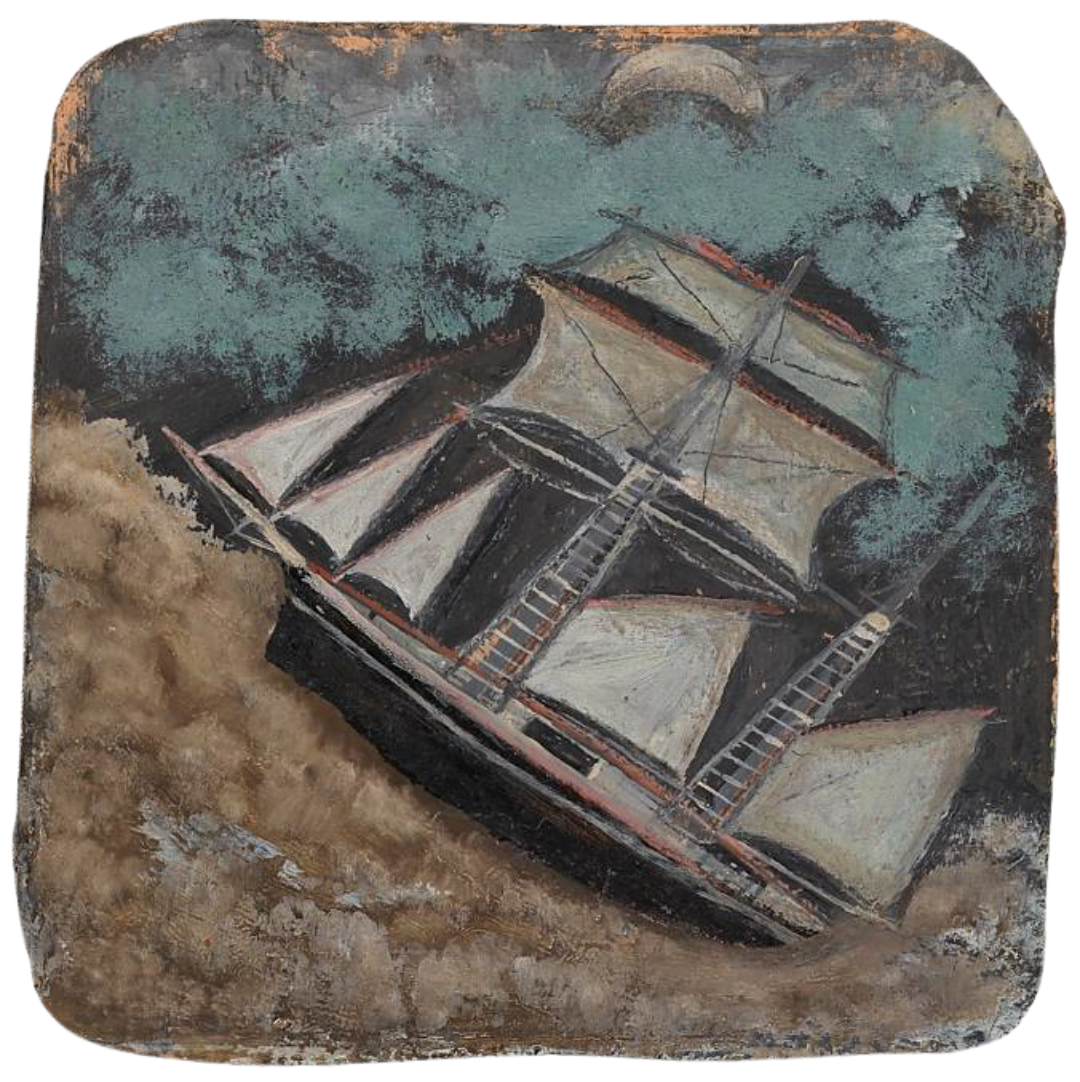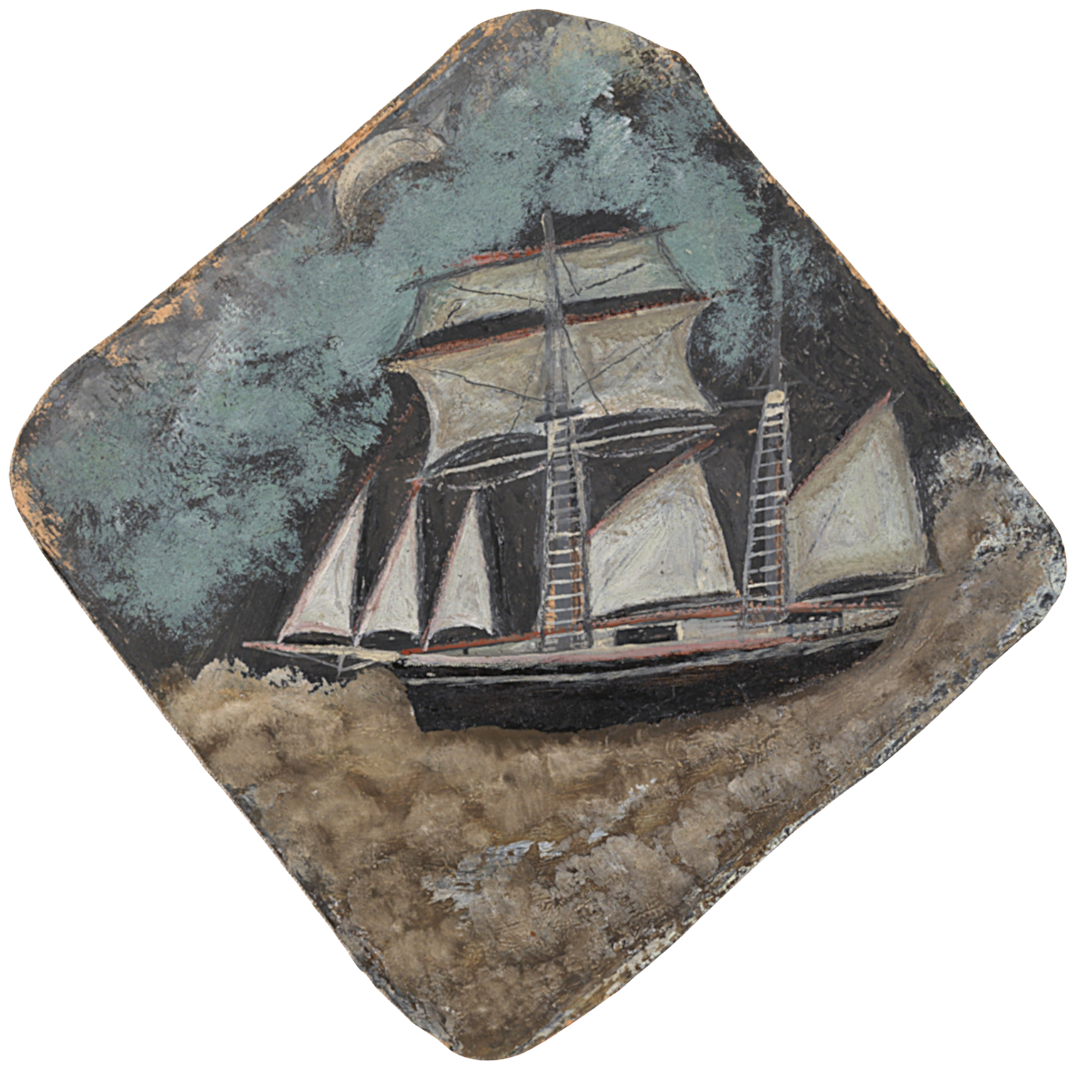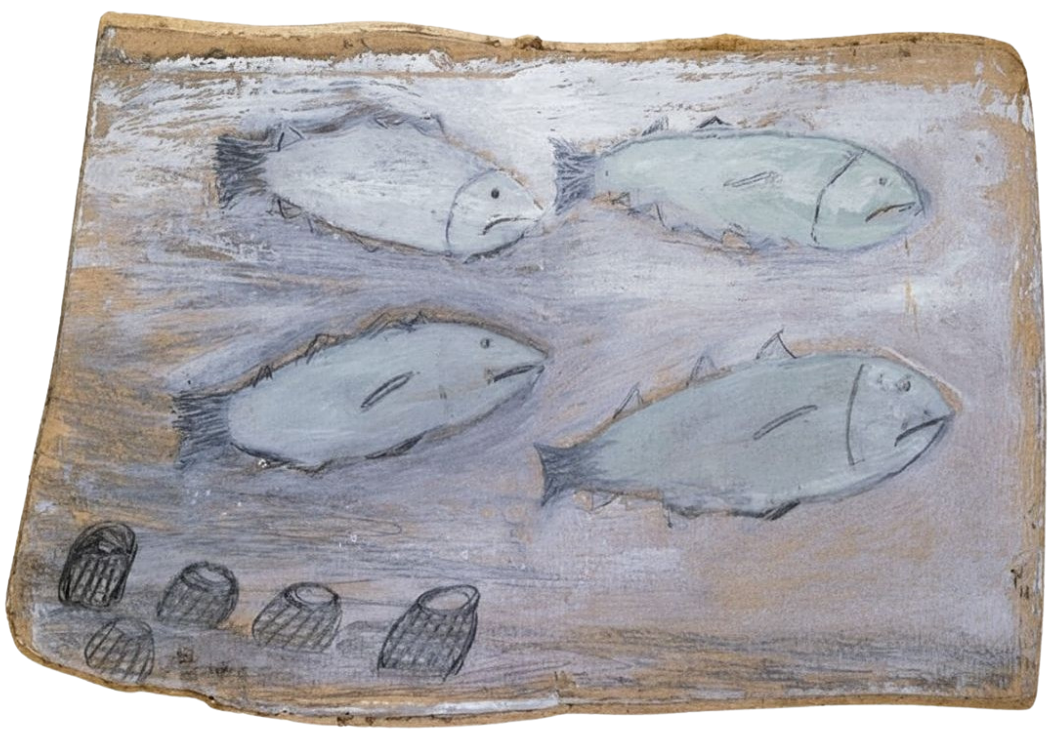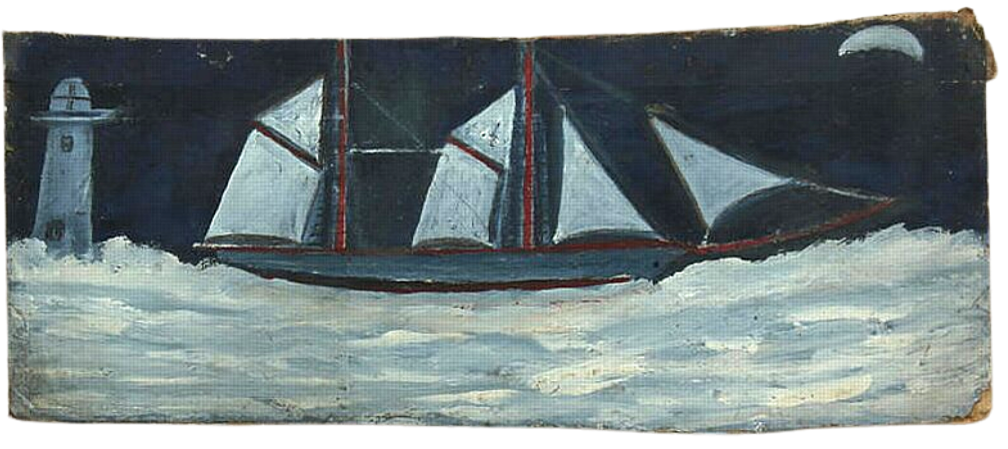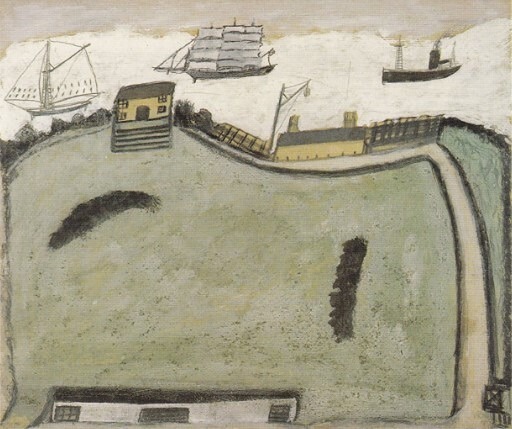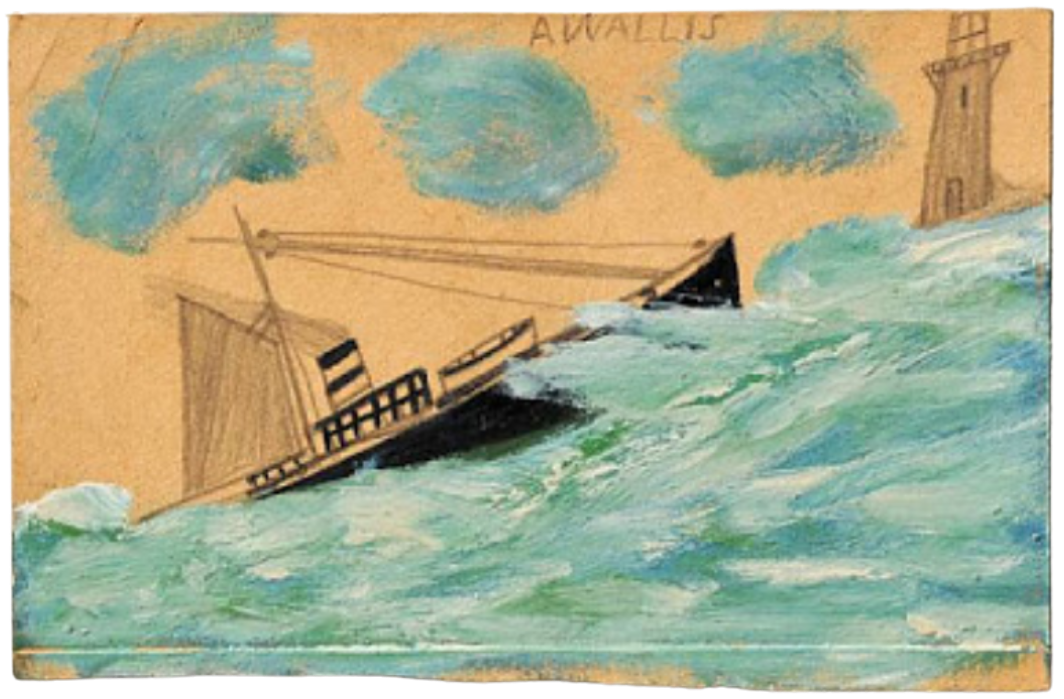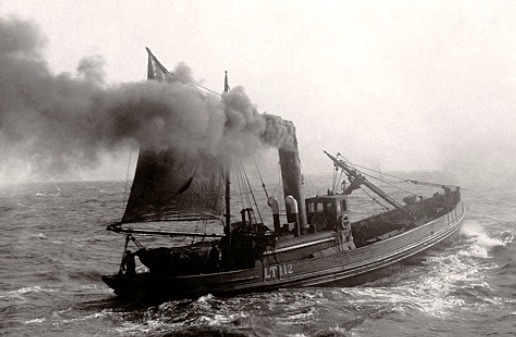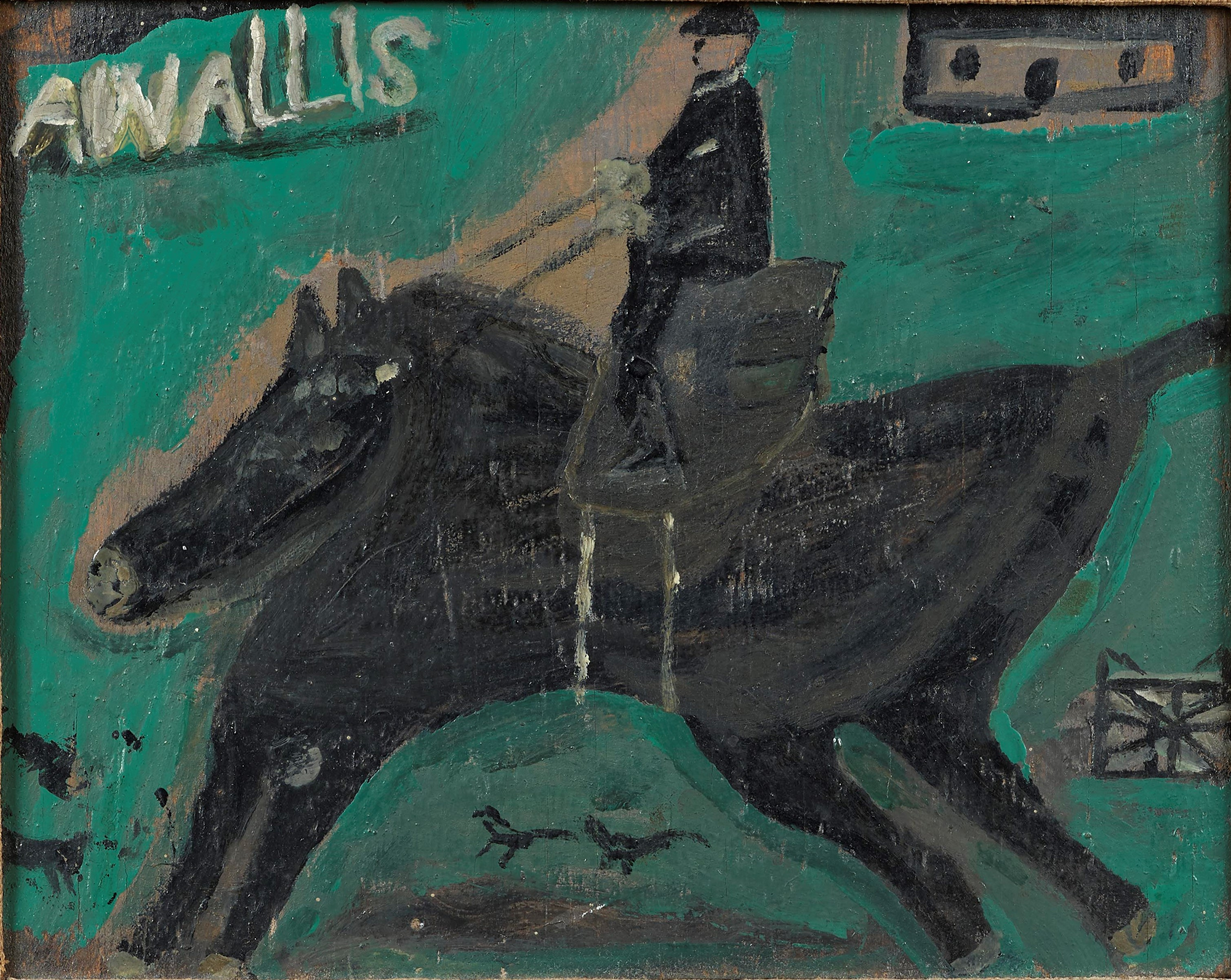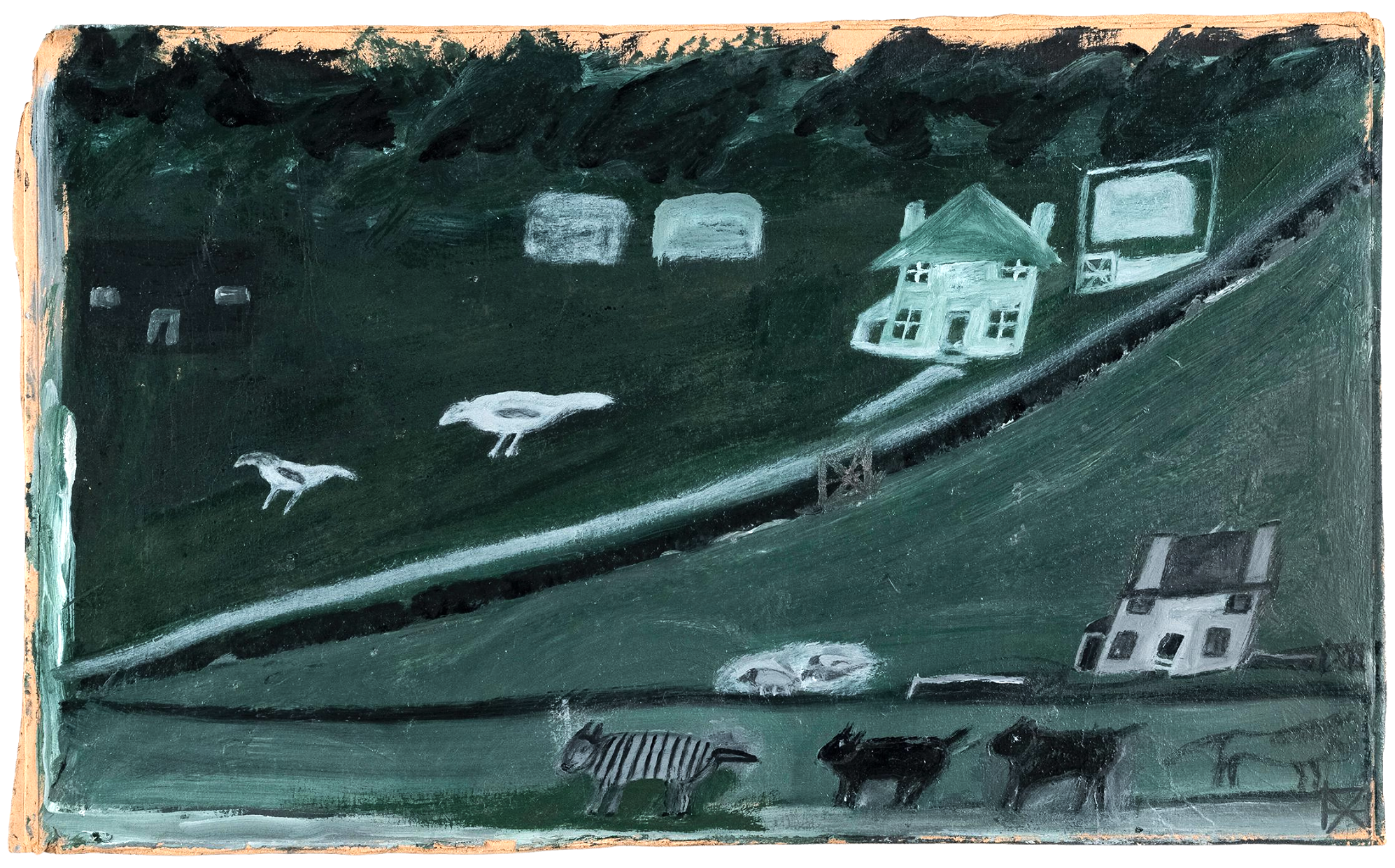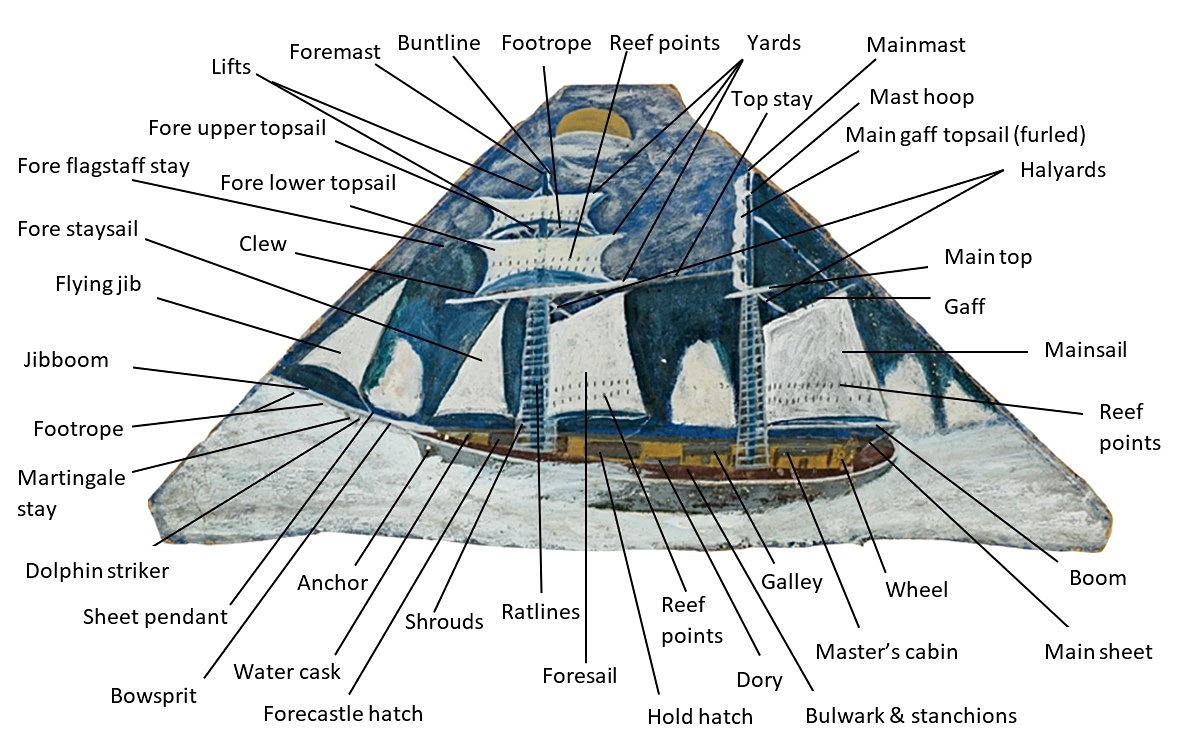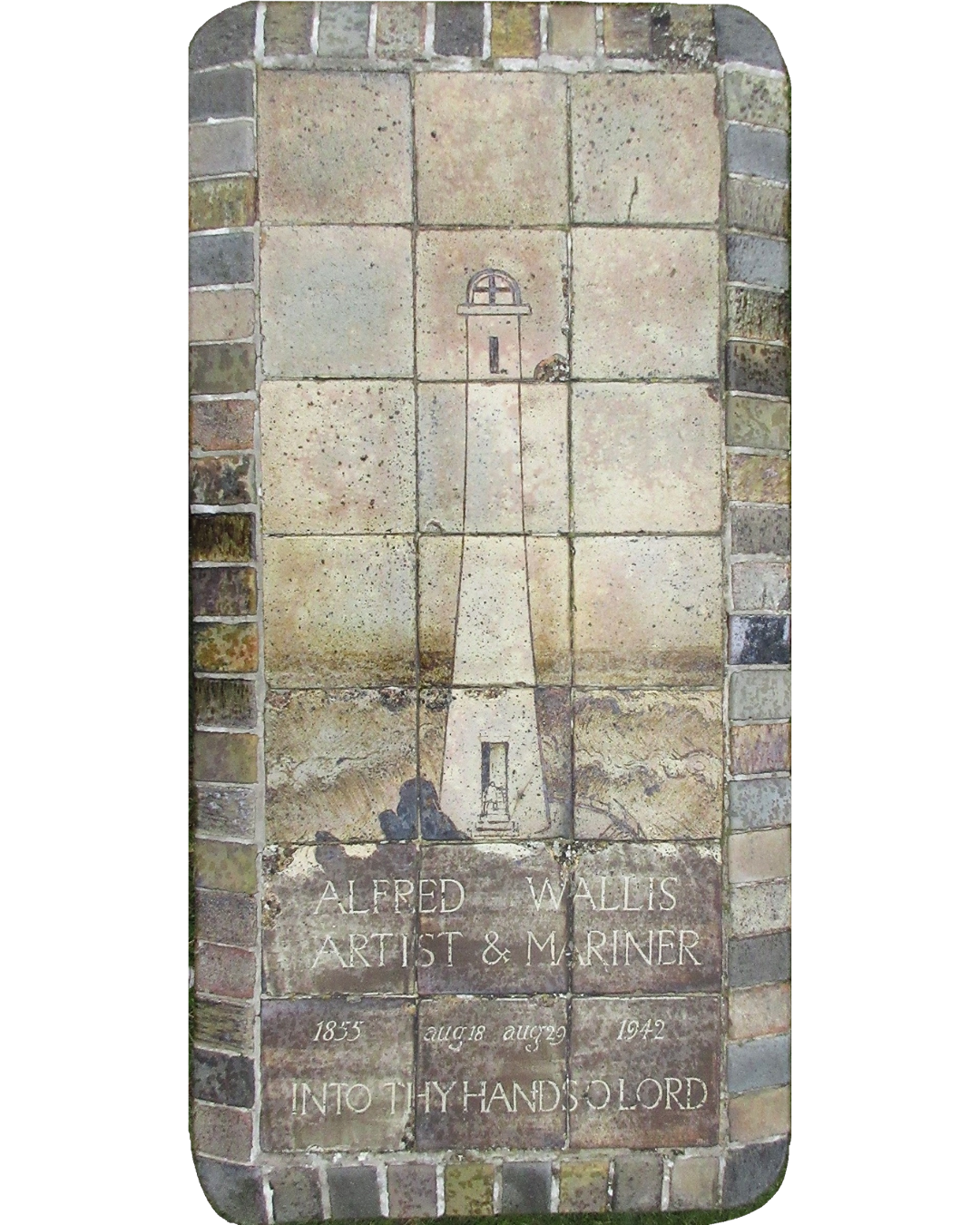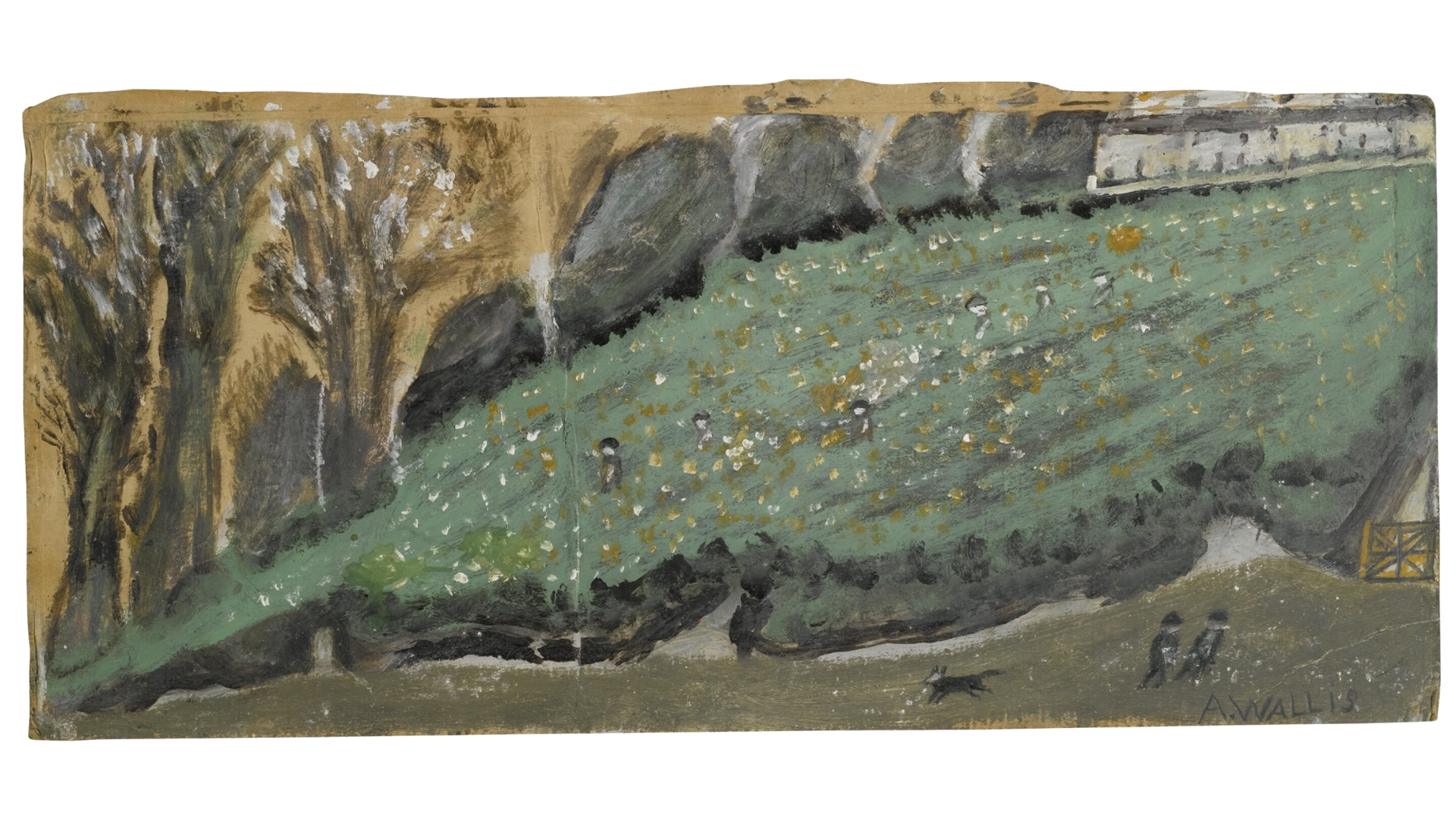~~ 27 October 2025 ~~
This black lion by Alfred Wallis sprung to mind on seeing that it's 'National Black Cat Day' today. The remarkable painting may be Wallis's interpretation of the rhetoric of General William Booth of the Salvation Army, to which Wallis became a devoted adherent in 1904.
Booth exhorted his followers to resist evil by fighting the Devil “who, as a roaring lion, will be ever going about to devour his soul.”
The composition is dominated by the lion, which appears to be guarding access to a railway viaduct, hindering any means of escape.
~~ 21 October 2025 ~~
The subject of this Alfred Wallis painting at Kettle's Yard has been variously identified as Gibraltar, St Michael’s Mount, and Portland in Dorset.
I believe it was Wallis's memory of a painting he saw and was photographed beneath (third image) at the St Ives Society of Artists summer exhibition in 1928. That painting appears to be of the Isle of Ischia in the Bay of Naples. Pictured here is a detail from the 19th century painting 'View of Ischia with the Aragonese castle' by Oswald Achenbach - complete with steamer passing by.
~~ 14 October 2025 ~~
On this day in 1876, the storm raged and the Belle Aventure was in danger of capsizing. Alfred Wallis told how he and the crew righted the ship by “making a chain and passing the cargo of dead fish up from the hold through the hatchway, one to the other across the deck and throwing it into the sea.”
Sadly, their companions on the Recruit were not so fortunate.
Their vessel was lost with all hands. Wallis would often speak of it with sorrow, “That boat never saw home again; it ran into the heavy gale and all hands were lost.”
If not for the expertise of ship's master Edwin Snell (pictured), and the supreme efforts of the crew, they might have joined their friends and the 2,679 other British merchant mariners who drowned at sea in 1876. Having remained a statistic for almost 150 years, the Recruit's crew are remembered here:
Thomas Tonkin (Master), 41, of St Ives; John Quick, 24, of St Ives; Henry Clark, 25, of Ipswich; and Emil McKahn, 25, of St Thomas
The events of that fateful week in October 1876 never left Wallis.
In the 1930s, he often painted two-masted schooners climbing treacherous waves - their topsails furled, and only the standing jib and gaff sails set to face the storm (scroll for images).
~~ 12 October 2025 ~~
On this day in 1876, Alfred Wallis and the crew of the Belle Aventure were caught in what Captain Edwin Snell recorded in his log as “a succession of heavy gales”.
The ferocious storm lashed the North Atlantic, even damaging the ships of the 1876 British Arctic Expedition as they rounded the southernmost tip of Greenland on 12 October.
Wallis’s striking painting 'Schooner Under The Moon' is hung diamond-shaped at Tate St Ives - sailing calmly across the sea (second image). But turned upright, it tells another story: the Belle Aventure battling mountainous waves under one of Wallis’s signature moons, ‘eating up the clouds’ (see post of 2 October below).
Wallis and his crew mates would have to fight for their lives.
~~ 8 October 2025 ~~
On this day in 1876, Alfred Wallis and his fellow crew mates finished loading their ship, the Belle Aventure, with a cargo of dried cod at Batteau Harbour, Labrador. To keep the schooner trim at sea they needed to load a hundred and forty tons of cod, and place each fish in flat and even rows in the hold. This meant the men had to hand-stow a staggering three hundred and thirty-six thousand individual dried cod.
This is a wonderful painting by Alfred Wallis titled 'Four Fishes'.
~~ 2 October 2025 ~~
This lovely painting shows how Alfred Wallis often painted the moon as a crescent with the horns pointing down instead of upwards, which is an exceptionally rare astronomical anomaly. Wallis’s moons may depict another belief once firmly held by sailors, that when the moon rose in a storm it would 'eat up the clouds', clearing the sky and providing assurance to 'many an old seaman during anxious watches'.
~~ 25 September 2025 ~~
A big thank you to everyone who came along to my St Ives September Festival walks, and my joint talk with the wonderful Ethan Carney, which saw a full house last night. Many thanks to Porthmeor Studios for hosting us in such an atmospheric venue, just a few steps away from the cottage where Alfred Wallis lived and painted on Back Road West.
This is one of a number of paintings Wallis did of the Island at St Ives.
~~ 15 September 2025 ~~
In the 1870s, Alfred Wallis worked as a fisherman on sailing luggers out of Newlyn. These boats drifted with the tide, using 'drift nets' to catch fish. In 1877, the first of many purpose-built 'steam luggers' arrived in Cornish waters. They also used the drift method, but once the nets were hauled, they could speed to market and fetch the highest prices for their catch.
These steam drifters clearly made an impression on Wallis, as he often painted them from memory in the 1930s.
The example shown here illustrates how he captured their distinctive lugger sails, smokestacks, and steeped (angled) foremasts - lowered at sea to aid drifting, net handling, and safer passage under steam, as seen in the photograph (second image).
~~ 8 September 2025 ~~
Another great example of a non-nautical scene by Alfred Wallis is this one titled 'Horse and Rider'. Wallis sold this painting to art critic Herbert Read, telling him he was proud of it because he found it "very difficult to shape a horse".
Read more about Wallis's interactions with the art critics and collectors who bought his work in the 1930s in the book.
~~ 7 September 2025 ~~
This is a lovely example of the countryside depictions Alfred Wallis liked to paint. In the field with animals below the duck pond is a striped donkey, which Wallis wrote about on the back of the painting:
"Their was a donkey Sold By aucton fetched 2000 pounds ad stripes like one duren The war i saw very Scarce To see one with stripes.”
This was likely to have been a zebra–donkey cross - a very rare hybrid known as a zenkey, zonkey, zebrass, or zedonk.
~~ 2 September 2025 ~~
Alfred Wallis was said to depict the rigging of his ships in incredible detail. I didn’t fully appreciate this until I sat down with his 'simple' painting of a two-masted topsail schooner and began labelling every part I could see.
It didn’t take long to realise just how well Wallis really knew his ships.
The painting is thought to depict the Belle Aventure, the schooner Wallis sailed on to Labrador, passing icebergs on the way.
~~ 29 August 2025 ~~
On this day eighty-three years ago, Alfred Wallis died in the former workhouse at Madron, aged 87.
Margaret Mellis recorded in her diary that her husband, Adrian Stokes, halted Wallis’s family funeral at Barnoon Cemetery part-way through. They took Wallis’s coffin back to Carbis Bay, where it is believed to have been stored in the garage of Stokes’s house until a second funeral was arranged.
Stokes purchased a grave in the Anglican section of the cemetery, though as a committed member of the Salvation Army, Wallis may have preferred to be buried in the original grave in the non-conformist section alongside his family.
After the funeral, Wallis’s grave lay unmarked for three years until it was covered with the beautiful tiles, pictured here, made by potter Bernard Leach.
The tiles bear the inscription:
ALFRED WALLIS
ARTIST & MARINER
1855 aug 18 aug 29 1942
INTO THY HANDS O LORD
Above, a lighthouse stands sentinel amidst huge waves with, in Leach’s words, “a door at the bottom and a little man climbing into the dark to climb into the light”.
~~ 24 August 2025 ~~
Alfred Wallis is best known for his paintings of ships and harbours. But one of his lesser known subjects is flowers in bloom. Just as he chose to paint working vessels rather than leisure ones, his flower scenes depict an important aspect of Cornish horticulture, which can still be seen in fields across Cornwall today. In this painting, simply titled ‘Picking Flowers’, Wallis shows several figures picking the annual daffodil harvest. This charming painting effortlessly conveys a simple rural scene, with people at work in the field beneath the warmth of the sun, whilst a dog runs down the lane and two passers-by stop for a chat.
~~ 14 August 2025 ~~
Having an epiphany today - not only does this children's book explain why I'm obsessed with the sea, I finally understand why I've been so driven to produce a work that gives Alfred Wallis the respect he deserves.
The way things turned out for Old Winkle was always a comfort to me as a child, no matter how many times I read it. Old Winkle was a gentle, solitary fisherman who found joy in feeding the seagulls from his old-fashioned boat while the other fishermen mocked him. When the town’s fish vanished and hunger spread, it was the seagulls who guided him to a hidden shoal. By sharing his catch, Old Winkle saved the town, and discovered the warmth of friendship he had never known.
~~ 8 August 2025 ~~
A massive thank you to everyone who joined my author Q&A at the Rose Lodge on 8 August to celebrate 170 years since Alfred Wallis’s birth and 100 years since he first picked up a paintbrush.
It meant a great deal that St Ives residents marked such an important centenary - overlooked everywhere else - in such a fitting location on the harbour that Alfred Wallis loved to paint so much.
Huge thanks to Tony Farrell for hosting us in the Rose Lodge - one of the Fishermen’s Lodges on St Ives Harbour - and for raising the Cornish flag to mark the occasion!

~~ 5 August 2025 ~~
A centenary worth celebrating
In August 1925 Alfred Wallis turned 70 and became eligible for the Old Age Pension. For the first time in his life, he had a modest but regular income. No longer having to work to make ends meet, he had more time on his hands, and this was likely the catalyst for him to take up painting as a hobby. Shortly after receiving his first pension, Wallis told his friend Richard Edwards, the watchmaker in Fore Street, “I dono how to pass away time. I think I’ll do a bit’a paintin’ – think I’ll draw a bit.”
Abridged excerpt from Alfred Wallis Child Pauper To Artistic Luminary
~~ 30 July 2025 ~~
The subject of this painting at the Jenna Burlingham Gallery is one Alfred Wallis painted many times, focussing on two old buildings in Porthmeor Square in St Ives. Wallis always depicted them as one, which is how they appeared from his cottage window, as seen in the second scrolled image.
"The two old buildings comprise the end wall of number 2 Back Road West (on the left) and the end wall and façade of the eighteenth-century building now known as Norway Cottage. Wallis referred to them as the “old house” and inscribed this name on several of the many examples he painted.
The building was considered singular enough not only to be painted by Wallis, but also by several other artists, including watercolourist Albert Foweraker in the early 1900s, and Australian artist Rose Lowcay in 1909. It was also photographed several times in the early twentieth century, most notably in 1913 (shown here) as part of an extraordinary international project - headed by French photographer Albert Kahn - to make a photographic record of all the countries of the world, known as The Archives of the Planet."
Abridged excerpt from the book.
~~ 22 July 2025 ~~
If you have a favourite Alfred Wallis painting, why not tell me which one it is and why you like it, and I'll post it here.
You can see lots of examples in permanent gallery collections and past auction results here and by following the links on this website.
There are also over a hundred faithfully reproduced colour illustrations of Alfred Wallis’s paintings in the book.
~~ 20 July 2025 ~~
COUNTING DOWN MY TOP FIVE FAVOURITE ALFRED WALLIS PAINTINGS
No. 1 - Here is my favourite painting by Alfred Wallis ❤️❤️❤️
Simply titled by an auction house as Schooner Passing a Lighthouse, this impressively large painting is not only beautiful in every way, it holds a wealth of information about Wallis's life, his emotions, and his approach as an artist.
The composition is done with boat paint on a metre-length piece of board, and I firmly believe it to be Wallis's record of his departure from Penzance and his new wife in April 1876, aboard the schooner Pride of the West bound for Newfoundland and Labrador.
"As a self-taught artist, Wallis was not confined by academic conventions of proportion and this painting exemplifies the way he often portrayed subjects relative to the emotional significance they held for him. As the ship would be his only haven for the foreseeable future, the topsail schooner dominates the composition. It is sailing towards the prominently-depicted Lizard lighthouse, regarded by mariners as the last point of departure from the English coast. Conversely, needing to suppress all thoughts of home, Penzance is shown in miniature in the top right-hand corner, just to the left of St Michael’s Mount. The ship is sailing away from all that was familiar to Wallis, and he has included the harbours, landmarks and lighthouses of Mount’s Bay and St Ives Bay beyond.
This remarkable painting could well be the one described by his friend Andrew Armour: "St. Michael’s Mount, Penzance, the Longships, an’ all the bloody lot. Wonderful. Best painten I ever see"."
Abridged excerpt from the book, which contains further details and paintings from Wallis’s time at Newfoundland and Labrador.
~~ 19 July 2025 ~~
COUNTING DOWN MY TOP FIVE FAVOURITE ALFRED WALLIS PAINTINGS
No. 2 - I love everything about this beautiful painting of the schooner Golden Light of Penzance: the austere use of colour that balances so well, the wave climbing the lighthouse, the effect of leaving the background unpainted, and the movement of the vessel through the churning sea. I love Wallis's confident signature and the fact that he has inscribed the name of the ship.
Wallis rarely titled his paintings, but when he did, it usually signified that he felt a strong affinity to the subject he was depicting. However, I’ve not yet found his name on any crew lists for this Penzance-registered schooner.
The Golden Light was built in 1864 and, remarkably, was one of the last schooners to survive from the great age of sail. It carried provisions during the First World War until sinking in 1918. Even if Wallis never worked on this vessel, he clearly wished to commemorate its existence.
There are over a hundred images of Alfred Wallis’s paintings to enjoy in Alfred Wallis Child Pauper To Artistic Luminary
~~ 18 July 2025 ~~
COUNTING DOWN MY TOP FIVE FAVOURITE ALFRED WALLIS PAINTINGS
No. 3 - There are several things about this striking painting that puts it in my top five.
It is an early painting, done by Wallis between 1925 and 1928 (note the nail holes where he pinned it up). It depicts the houses near his cottage in St Ives, including one he often painted in Porthmeor Square (to feature in a future post). The painting also encompasses the Island with its chapel, and three boats sailing by. I love how Wallis has depicted these vessels simply and on a small scale, yet still made them recognisably a steamer, a fishing lugger, and a barque.
The whole composition shows Wallis's joy and confidence as an artist - which is exactly how he felt when he gave this painting to Ben Nicholson when they first met in 1928:
'As he was leaving, Alfred thrust it into Nicholson’s hands, telling him he would give it to him as he would “find that it was a good one”. Nicholson subsequently wrote that Alfred’s judgement was completely right, as he came to consider the painting one of the best he owned.'
Abridged excerpt from Alfred Wallis Child Pauper To Artistic Luminary
~~ 17 July 2025 ~~
COUNTING DOWN MY TOP FIVE FAVOURITE ALFRED WALLIS PAINTINGS
No. 4 - I love this painting because it says so much about Alfred Wallis's artistic sense of colour and form.
"Wallis was often given old advertising cards to paint on, including this 1930s example of a woman posing in an elasticated girdle. No doubt wishing to protect her modesty, he painted clothing over her body, but what is fascinating is that he cared as much about the colour and design of this composition as he did for many a vessel at sea.
Accordingly, after painting a long sleeve of the mustard-coloured top over her left arm, he changed his mind and repainted it white to match her right one. In a complete departure from the norm he chose red as the colour of her skirt. By adding characteristic houses at her feet, vast trees to frame her torso, and a partially visible moon behind their topmost branches, he turned her into an ethereal being."
Abridged excerpt from Alfred Wallis Child Pauper To Artistic Luminary
~~ 16 July 2025 ~~
COUNTING DOWN MY TOP FIVE FAVOURITE ALFRED WALLIS PAINTINGS
No. 5 - This simple painting done with boat paint on a small piece of cardboard, holds great significance in the story of Alfred Wallis’s life. Wallis has depicted two Newlyn fishing luggers, both bearing the port registration number PZ11. The larger vessel is the Flying Scud, which he was said to have sailed on in the 1870s. However, after checking all the 19th-century crew lists for that vessel, I was unable to find Wallis’s name among them.
I did, however, uncover a second, smaller lugger with the same registration number in the 19th-century shipping registers held at Cornwall’s excellent archive, Kresen Kernow. This vessel, named the Slipper, has no surviving crew lists, but a compelling clue links Wallis to this boat: it was owned and skippered by his father’s first cousin.
Later in life, Wallis painted a lugger with PZ11 on its sails and wrote on the reverse:
“This is The numBer That i was in aBout 65 years ago i was sea sick i never Eat anything on Till we got to scarBro from newlyn.”
It therefore seems likely that the painting shown here - which ranks No.5 in my top five favourite Wallis paintings - is his memory of the time he sailed with the Mount’s Bay fleet on the Slipper, alongside the Flying Scud, to the North Sea herring grounds at Scarborough.
Further details about Wallis’s years as a fisherman in the 1870s can be found in Alfred Wallis Child Pauper To Artistic Luminary

~~ 11 July 2025 ~~
“On nearing the southern tip of Labrador, Alfred Wallis would have had his first view of icebergs; great numbers being reported near Bell Island at the time his ship reached it. These enormous masses of ice broke away each year from glaciers on the coast of Greenland and drifted slowly south on strong ocean currents. But in 1876 they were more numerous than usual due to a ferocious heatwave enveloping North Atlantic regions around the globe that summer, with highs of 40°C (104°F) recorded by the weather station at St John’s in Newfoundland.
Wallis depicted icebergs in a number of paintings, including several with his ship, the Belle Aventure; one painting showing the schooner sailing beneath a blue sky and glaring yellow sun, with icebergs to either side.”
Abridged excerpt from Alfred Wallis Child Pauper To Artistic Luminary

~~ 8 July 2025 ~~
“In April 1867, 11-year-old Alfred stood on North Corner Quay watching the huge Royal Navy ship HMS Megaera sail towards the open sea. His brother Charles, small and undernourished, was hiding in the ship’s Sick Bay. Charles had confided to Alfred that he was going to stowaway on the ship, hoping to escape the impoverished life they were living with their father in Devonport. Eleven of their siblings had died, and now their mother had succumbed to Tuberculosis.
But Charles was discovered. The next day he was brutally flogged on the ship. He was put ashore at Portsmouth, penniless and badly beaten.
What happened shocked the nation and made international news. It precipitated Charles and the Wallis family into the centre of a cause célèbre in a court drama that was covered extensively by the newspapers of the day. On 8 July 1867, Charles faced the might of the Royal Navy in a trial by jury whilst the Navy Captain who ordered his flogging faced condemnation and disgrace.”
Abridged excerpt from Alfred Wallis Child Pauper To Artistic Luminary

~~ 1 July 2025 ~~
A big thank you to everyone for coming along this morning to the Penzance LitFest Fringe to hear my talk 'Illuminating Alfred Wallis' - based around the definitive biography of the iconic St Ives artist Alfred Wallis.
Thanks also to the Redwing Gallery for providing a great venue for the event!
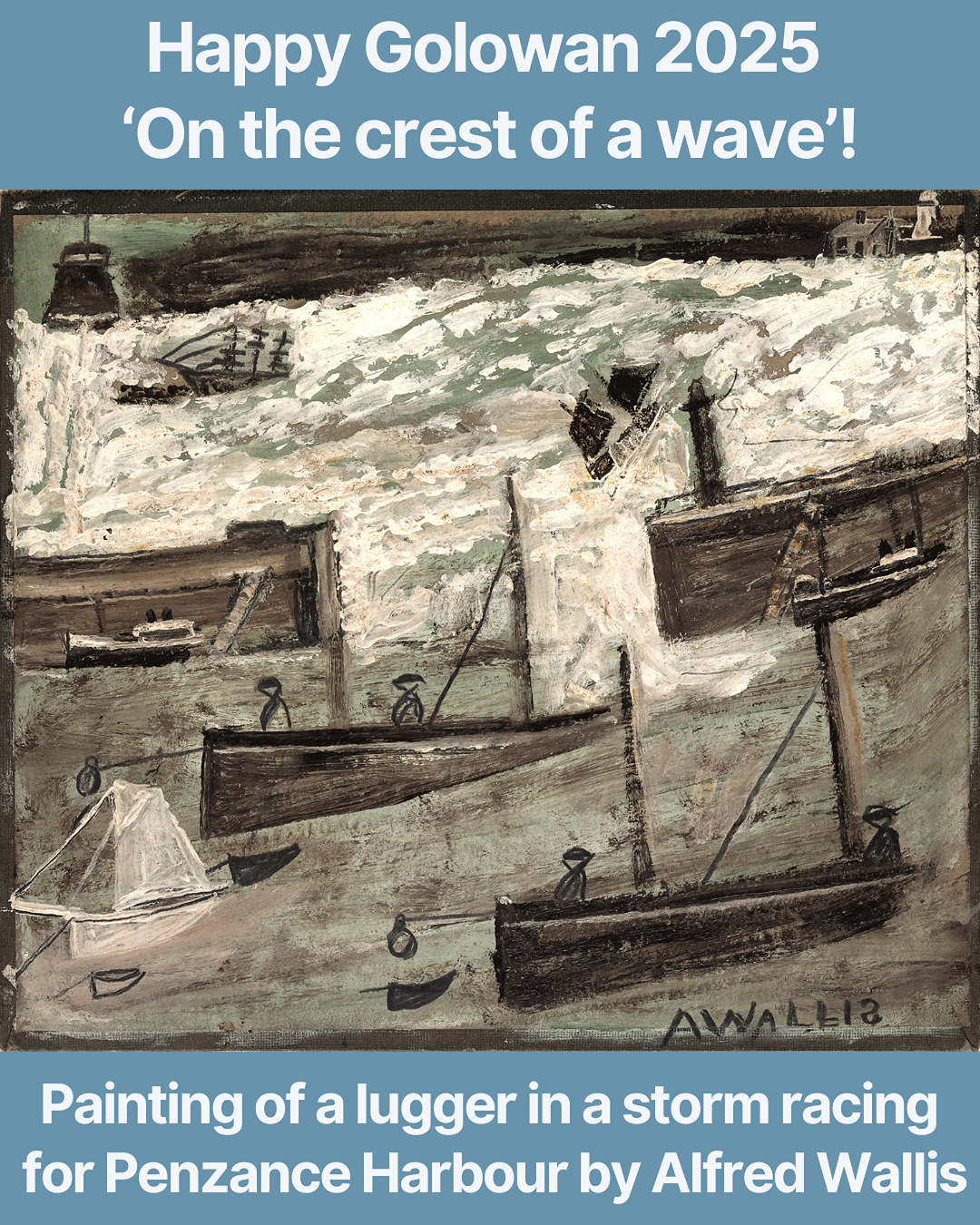
~~ 29 June 2025 ~~
“When Alfred Wallis was a cabin boy aged 11, he witnessed a great storm in Mount's Bay. It caused a square-rigged barque called the John Gray to founder on Gear Rock between Penzance and St Michael’s Mount. Most of the crew were rescued by the lifeboat, but the captain refused to leave the ship.
When it broke up, the captain drowned and the cargo of rum, coconuts and sugar washed up on the beach at Long Rock, where it was ‘strewed for a long distance on the sand’. Wallis often painted this subject in later life, showing how much it had affected him as a boy."
Abridged excerpt from Alfred Wallis Child Pauper To Artistic Luminary to celebrate Golowan Festival 2025
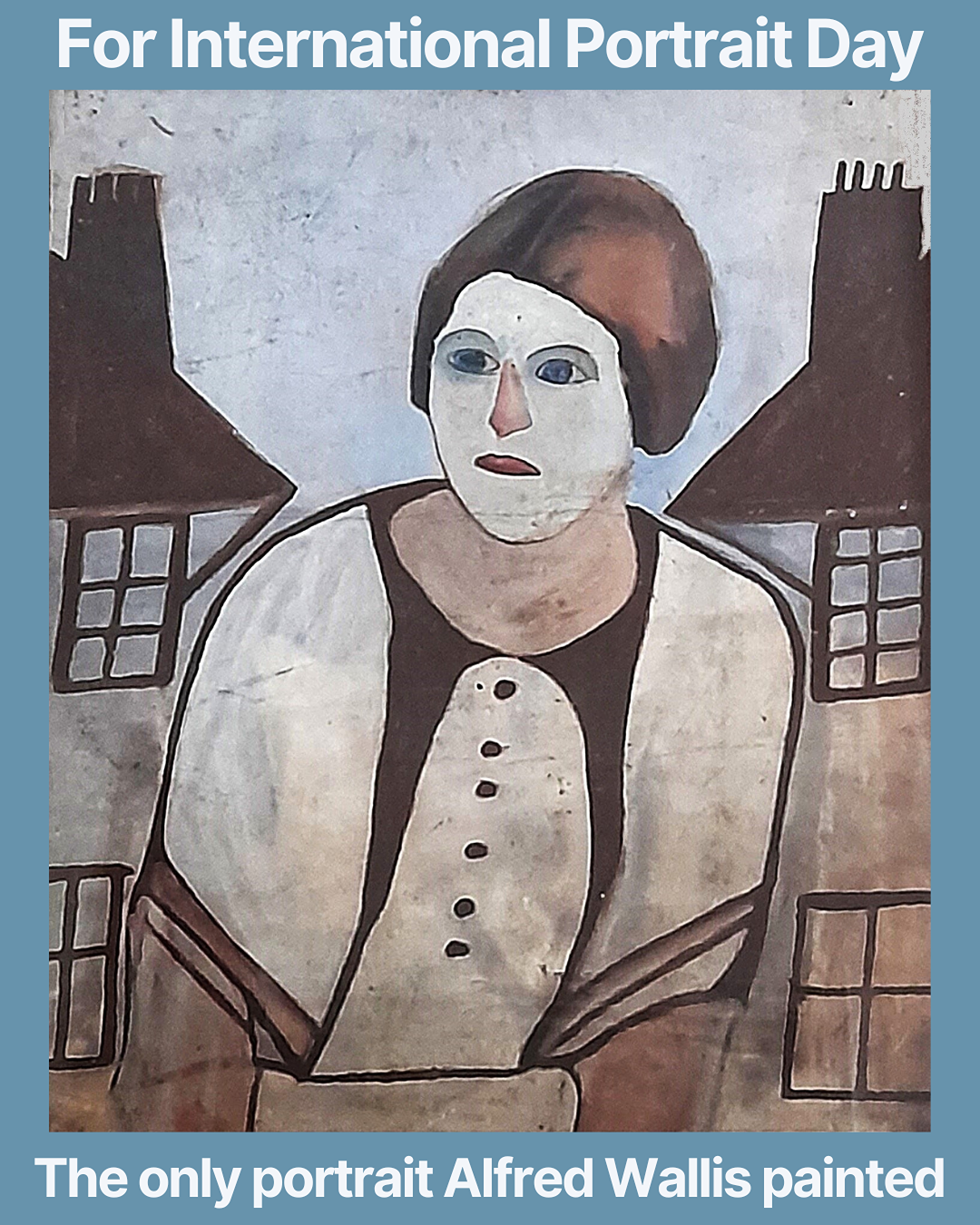
~~ 23 June 2025 ~~
To celebrate International Portrait Day, here is the only portrait Alfred Wallis made. It is thought to be of his wife, Susan, and is discussed in Alfred Wallis Child Pauper To Artistic Luminary. It is published in colour for the first time thanks to the kind permission of the portrait's owner.
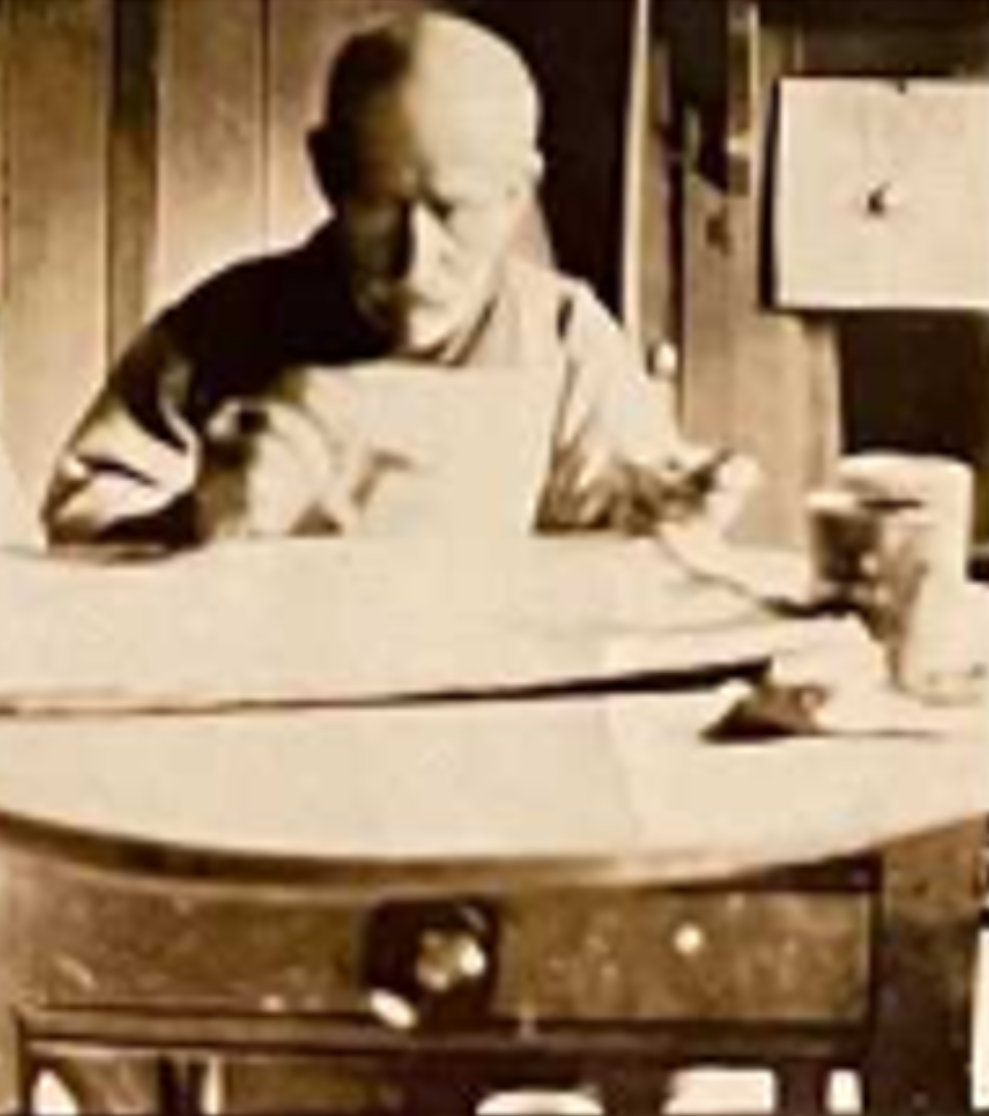
~~ 20 June 2025 ~~
Was born into extreme poverty in 1855
Went to sea as a cabin boy aged 10
Survived terrifying storms at sea
Was a caring stepfather
Ran a scrap merchants at St Ives
Taught himself to paint aged 70
Greatly influenced British Modern Art
Was paid very little for his paintings
Died in the workhouse in 1942
Is now one of Britain’s best-loved artists
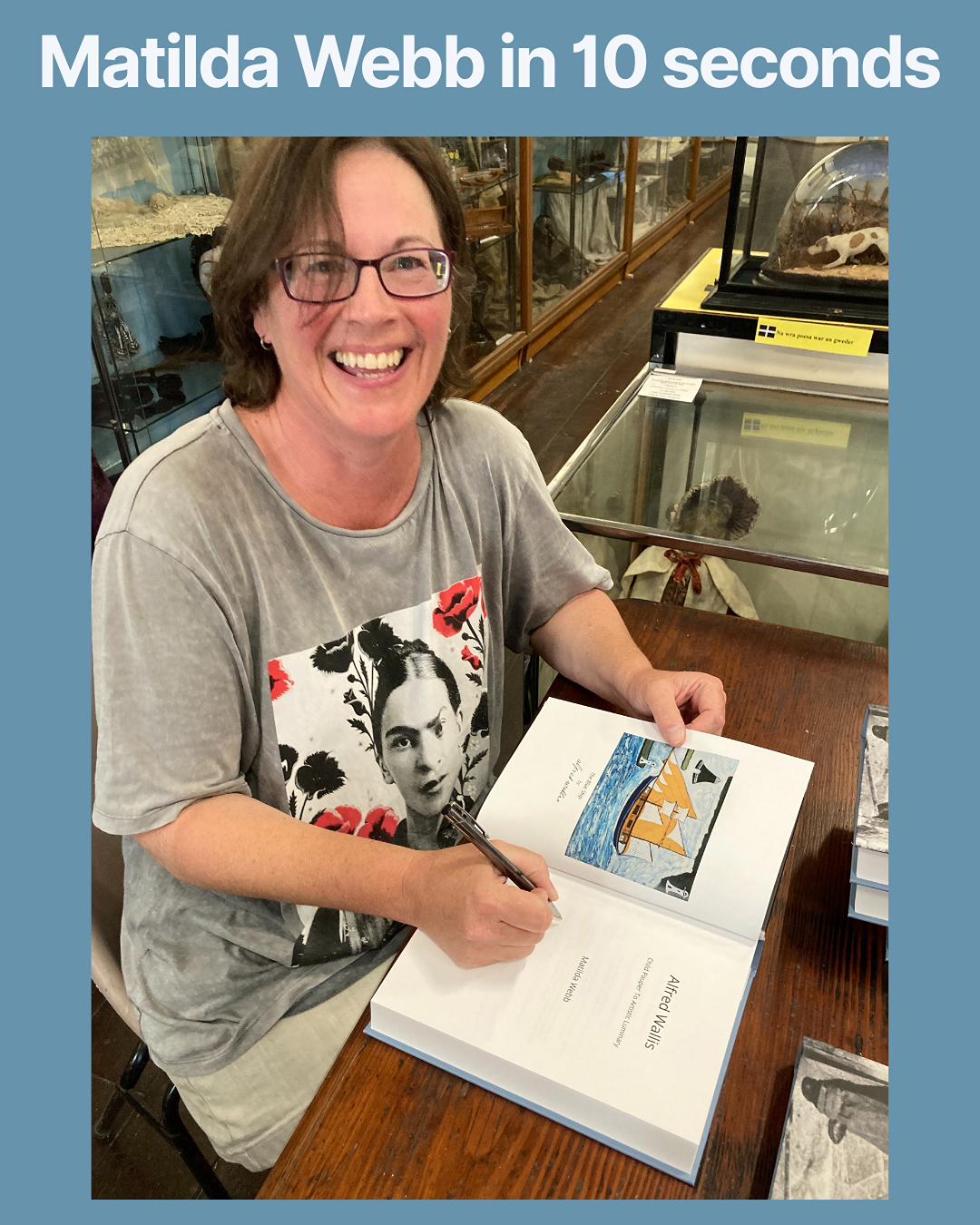
~~ 18 June 2025 ~~
Was born into an artistic family
Grew up on the coasts of Yorkshire and Pembrokeshire
Always loved Alfred Wallis’s paintings
Became a museum curator and historical researcher
Lived in Orkney and West Cornwall
Felt inspired to discover more about Alfred Wallis after seeing the collection of his paintings at Kettle’s Yard
Was surprised to find little biographical information
Spent 8 years visiting archives and tracking down members of Wallis’s family
Published this in-depth biography in April 2025
Is now exhausted!

